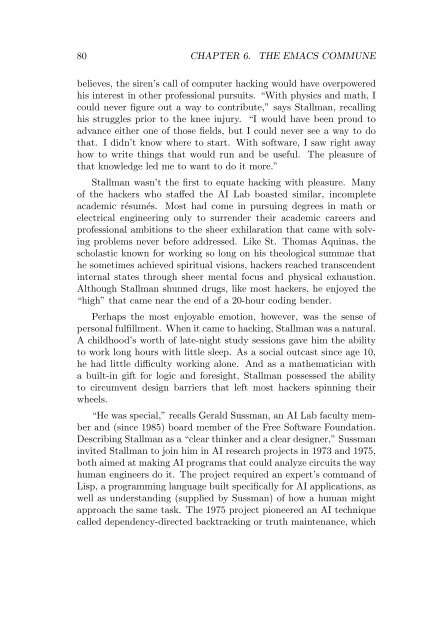Create successful ePaper yourself
Turn your PDF publications into a flip-book with our unique Google optimized e-Paper software.
80 CHAPTER 6. THE EMACS COMMUNE<br />
believes, the siren’s call of computer hacking would have overpowered<br />
his interest in other professional pursuits. “With physics and math, I<br />
could never figure out a way to contribute,” says Stallman, recalling<br />
his struggles prior to the knee injury. “I would have been proud to<br />
advance either one of those fields, but I could never see a way to do<br />
that. I didn’t know where to start. With software, I saw right away<br />
how to write things that would run and be useful. The pleasure of<br />
that knowledge led me to want to do it more.”<br />
Stallman wasn’t the first to equate hacking with pleasure. Many<br />
of the hackers who staffed the AI Lab boasted similar, incomplete<br />
academic résumés. Most had come in pursuing degrees in math or<br />
electrical engineering only to surrender their academic careers and<br />
professional ambitions to the sheer exhilaration that came with solving<br />
problems never before addressed. Like St. Thomas Aquinas, the<br />
scholastic known for working so long on his theological summae that<br />
he sometimes achieved spiritual visions, hackers reached transcendent<br />
internal states through sheer mental focus and physical exhaustion.<br />
Although Stallman shunned drugs, like most hackers, he enjoyed the<br />
“high” that came near the end of a 20-hour coding bender.<br />
Perhaps the most enjoyable emotion, however, was the sense of<br />
personal fulfillment. When it came to hacking, Stallman was a natural.<br />
A childhood’s worth of late-night study sessions gave him the ability<br />
to work long hours with little sleep. As a social outcast since age 10,<br />
he had little difficulty working alone. And as a mathematician with<br />
a built-in gift for logic and foresight, Stallman possessed the ability<br />
to circumvent design barriers that left most hackers spinning their<br />
wheels.<br />
“He was special,” recalls Gerald Sussman, an AI Lab faculty member<br />
and (since 1985) board member of the Free Software Foundation.<br />
Describing Stallman as a “clear thinker and a clear designer,” Sussman<br />
invited Stallman to join him in AI research projects in 1973 and 1975,<br />
both aimed at making AI programs that could analyze circuits the way<br />
human engineers do it. The project required an expert’s command of<br />
Lisp, a programming language built specifically for AI applications, as<br />
well as understanding (supplied by Sussman) of how a human might<br />
approach the same task. The 1975 project pioneered an AI technique<br />
called dependency-directed backtracking or truth maintenance, which


